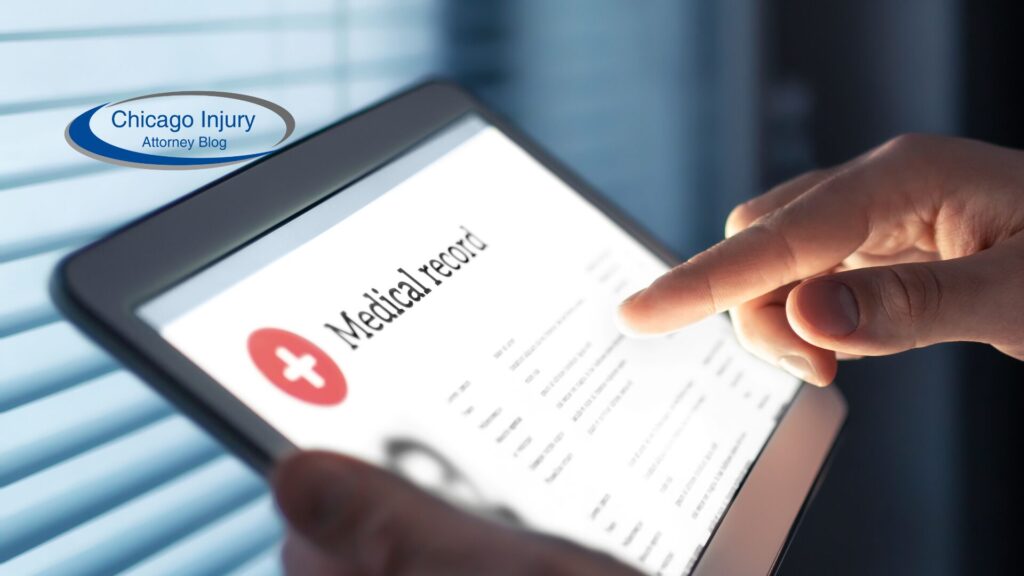Patient records play a crucial role in malpractice cases, shedding light on doctors’ responsibilities and healthcare professionals’ duties. In Chicago, Illinois, where personal injury victims seek justice, understanding the importance of accurate record-keeping in hospitals and facilities is essential.
This article explores risk management strategies, legal protection resources, and educational tools for medical professionals. Dive into the world of patient records and legal cases, and discover best practices for record-keeping in healthcare settings.
Key Takeaways:
Patient records play a critical role in malpractice cases, providing evidence of treatment, diagnosis, and consent.Medical professionals should stay informed on updates in the healthcare liability market and utilize risk management tools to protect themselves from malpractice claims.Hospitals and facilities must follow legal guidelines and best practices for record-keeping to avoid potential malpractice cases and protect both patients and providers.
The Importance of Patient Records in Malpractice Cases
In medical malpractice cases, the importance of patient records cannot be overstated. These records serve as essential documentation that can make or break a case, providing insights into the patient’s care, treatment, and outcomes.
Regarding establishing liability risks in malpractice lawsuits, detailed patient records are crucial. These records form the backbone of evidence, showcasing the care provided, medication administered, and responses observed.
Accurate and thorough documentation can potentially protect healthcare providers from unwarranted claims or errors that could lead to litigation.
Healthcare facilities need to ensure that their staff receives adequate training on proper record-keeping practices to maintain compliance and minimize legal risks.
Understanding Doctors’ Role
Doctors play a crucial role in ensuring accurate patient records in malpractice cases, as their clinical decisions, diagnostic accuracy, and treatment plans are directly reflected in the medical documentation.
Maintaining precise medical records is essential for providing quality healthcare and ensuring patient safety. When doctors meticulously document patient information, it not only aids in diagnosis and treatment but also serves as a legal record that can protect both the patient and the healthcare provider.
Accurate documentation plays a significant role in preventing potential diagnostic errors that could lead to malpractice claims. Inaccurate or incomplete records may result in miscommunication, poor decision-making, and ultimately harm patients. Proper documentation can help healthcare providers avoid misunderstandings, improve care coordination, and minimize legal risks.
- Doctors must pay attention to detail when documenting patient encounters, medical history, test results, medications, and treatment plans. Errors in documentation, such as incorrect patient information or misinterpreted lab results, can have serious consequences.
- Healthcare professionals, including nurses and administrative staff, also play a vital role in supporting accurate documentation practices. Collaborative efforts ensure that medical records are comprehensive, organized, and compliant with regulatory standards.
- Working closely with medical malpractice attorneys can provide doctors with legal protection and guidance in navigating complex malpractice cases. By partnering with legal experts, healthcare providers can better understand their rights, obligations, and potential liabilities, ultimately safeguarding their professional reputation and patient care.
Insight into Healthcare Professionals’ Responsibilities
Healthcare professionals bear the responsibility of ensuring that patient records are meticulously maintained, reflecting the quality of clinical care provided and minimizing documentation errors that could lead to malpractice allegations.
One of the major challenges faced by healthcare professionals in maintaining accurate documentation is the overwhelming amount of information they must record and analyze on a daily basis. The sheer volume of patient data, combined with time constraints and evolving regulatory requirements, can make it difficult to consistently document every detail accurately.
To overcome these challenges, effective documentation strategies such as standardized templates, electronic health records (EHR) systems, and regular training on documentation best practices are essential. These tools not only streamline the documentation process but also help ensure that critical information is captured and organized systematically.
Accurate healthcare documentation plays a crucial role in legal proceedings, as detailed and precise records can be instrumental in defending healthcare providers against malpractice claims. In contrast, incomplete or inaccurate documentation can weaken a provider’s defense and increase the likelihood of adverse legal outcomes.
Senior Care and Patient Record Management
Senior care facilities must prioritize meticulous patient record management to safeguard residents’ well-being and prevent instances of nursing home abuse, which can lead to severe legal consequences.
One of the unique challenges faced by senior care facilities lies in the complexity of managing patient records for elderly residents. The necessity for accuracy and detailed documentation cannot be overstated, as these records form the backbone of ensuring the safety and quality of care provided. In the unfortunate event of nursing home abuse cases, accurate documentation becomes essential not only for addressing the immediate concerns but also for protecting both residents and the facility against potential legal ramifications.
Importance of Accurate Records in Hospitals & Facilities
Hospitals and healthcare facilities must prioritize maintaining accurate patient records to minimize liability exposure, enhance patient safety, and provide comprehensive medical histories that support well-considered choices in clinical care.
The significance of precise record-keeping in healthcare settings cannot be overstated; every detail documented plays a crucial role in ensuring efficient treatment and continuity of care for patients. A detailed medical history acts as the cornerstone for healthcare providers to make well-informed diagnoses, tailor treatment plans, and anticipate potential risks or complications.
On the other hand, inaccurate documentation not only jeopardizes patient safety but also exposes healthcare professionals to increased liability risks. Errors or omissions in medical records can lead to misdiagnoses, incorrect treatments, or the inability to provide timely interventions.
To mitigate these risks, healthcare facilities should implement robust protocols for recording and maintaining patient information. Regular staff training on accurate documentation practices, utilizing electronic health records for streamlined data management, and conducting periodic audits to ensure accuracy are essential strategies to uphold record integrity and mitigate liability exposure.
Risk Management Strategies in Malpractice Cases
Implementing effective risk management strategies is essential for healthcare professionals and institutions to mitigate liability risks associated with medical malpractice lawsuits, ensuring proactive measures are in place to address documentation errors and liability exposure.
One key strategy is to conduct regular risk assessments to identify potential areas of vulnerability and take proactive steps to address them. This can include implementing clear protocols for patient care, ensuring staff are properly trained, and maintaining accurate records.
Documentation audits play a crucial role in risk management by verifying the accuracy and completeness of medical records. By conducting regular reviews, healthcare providers can identify any inconsistencies or gaps that may pose legal risks and take corrective actions promptly.
Continuous training and education are vital components of risk management, as they keep healthcare professionals updated on the latest industry standards and best practices. Regular training sessions can help improve clinical skills, enhance communication with patients, and ensure compliance with regulatory requirements.
Prevention Center Resources for Legal Protection
Utilizing prevention center resources can offer healthcare professionals valuable guidance on establishing robust documentation policies, obtaining informed consent, and minimizing liability risks in medical practice.
Through these resources, healthcare providers can access templates, guidelines, and training materials that facilitate the development of detailed documentation policies. By incorporating best practices recommended by prevention centers, medical professionals can enhance their ability to accurately record patient information and treatment plans, thereby reducing the likelihood of errors and potential legal disputes.
Prevention centers play a crucial role in educating healthcare staff on the importance of obtaining comprehensive, informed consent from patients. They provide tools and strategies to ensure that patients fully understand the risks, benefits, and alternatives associated with proposed treatments, thereby promoting transparency and patient autonomy.
By adhering to the guidance and standards set forth by prevention centers, healthcare providers can proactively mitigate liability risks in patient care. By staying updated on legal requirements and implementing proactive measures, such as regular audits and quality assessments, medical practices can minimize the chances of facing malpractice challenges and lawsuits.
Educational Resources for Medical Professionals
Educational resources tailored to medical professionals play a vital role in enhancing their understanding of medicolegal principles, legal precedents, and relevant case studies, providing valuable insights into the intersection of healthcare and the law.
One such valuable resource is the Westlaw legal database, known for its comprehensive collection of up-to-date legal information, landmark cases, and best practices in medicolegal compliance. By utilizing tools like Westlaw, healthcare professionals gain access to a wealth of knowledge that can inform their decision-making processes and aid in effective risk management.
Integrating legal knowledge into medical practice not only ensures that practitioners are well-informed about the legal implications of their actions but also enables them to navigate complex ethical and legal issues with confidence. This integration fosters a culture of accountability and compliance within healthcare institutions, ultimately leading to better patient outcomes and reduced legal risks.
Updates on Healthcare Liability Market
Staying informed about the evolving landscape of the healthcare liability market is essential for medical professionals to navigate regulatory changes, compliance requirements, and accreditation standards set by organizations like the Accreditation Council for Graduate Medical Education.
Recent developments in the healthcare liability market have highlighted a growing emphasis on transparency and accountability in medical practice. Healthcare providers now face increased scrutiny to ensure patient safety and quality of care. With stricter regulations, professionals must stay updated on malpractice risk management strategies to mitigate potential liabilities.
The evolving landscape has underscored the significance of continuous medical education to enhance clinical competency and uphold ethical standards. Healthcare professionals need to prioritize ongoing learning to adapt to changing regulations effectively and deliver optimal patient outcomes.
Significance of Consent Provisions in Records
Incorporating comprehensive consent provisions in electronic health records ensures that patients’ rights are respected, privacy is protected, and crucial patient information is accurately documented for legal and ethical compliance.
Clear documentation of patient agreements, disclosures, and privacy protections is vital within electronic health records. It not only safeguards patient privacy but also plays a crucial role in well-considered choices, treatment planning, and compliance with regulatory guidelines on consent documentation.
By ensuring that patients are fully informed and have consented to specific treatments or interventions, healthcare providers can enhance the quality of care and build trusting patient-provider relationships. Patient information within these records helps healthcare professionals make informed decisions, track treatment progress, and tailor medical care to individual needs, improving overall healthcare outcomes.
Advantages of Occurrence Coverage for Malpractice
Opting for occurrence coverage in malpractice insurance offers healthcare professionals advantages in managing liability risks associated with documentation errors, ensuring comprehensive protection for incidents that occur during the policy period.
This type of insurance provides financial security by covering claims made even after the policy has expired, which is particularly beneficial for healthcare providers dealing with long-term risks related to medical malpractice cases. By securing occurrence coverage, healthcare professionals can rest assured knowing that they are protected against lawsuits stemming from past patient interactions, thereby avoiding potential financial burdens that may arise from delayed claims. This type of coverage typically offers more comprehensive protection compared to claims-made policies, as it addresses incidents that occurred during the policy period without any limitations based on when the claim is filed.
Learning from Mock Trials: Case Study Analysis
Engaging in mock trials for case study analysis can provide valuable insights for healthcare professionals to identify documentation errors, analyze clinical care practices, and enhance risk management strategies to prevent malpractice challenges.
Participating in these simulated scenarios allows healthcare professionals to experience firsthand the complexities of navigating legal and ethical dilemmas in their field. By thoroughly examining case studies and dissecting pertinent details, participants can gain a deep understanding of how documentation errors can impact patient outcomes and lead to liability issues.
Through the process of role-playing in these mock trials, healthcare professionals can hone their skills in patient communication, critical thinking, and evidence-based decision-making. This hands-on approach helps them improve the quality of clinical care, thus reducing the likelihood of facing malpractice claims.
Building a Glossary of Insurance Terms for Clarity
Creating a comprehensive glossary of insurance terms can enhance clarity and understanding for medical professionals, healthcare providers, and legal professionals involved in navigating the complexities of medical malpractice insurance policies and documentation requirements.
This glossary serves as a vital tool for stakeholders in the healthcare and legal sectors, aiding in the interpretation of intricate insurance jargon related to medical malpractice claims, coverage limits, premium calculations, and claim settlement processes. Understanding these terms is crucial for accurate risk assessment, policy selection, and compliance with regulatory frameworks. By demystifying obscure insurance terminology, professionals can effectively communicate, negotiate, and mitigate legal disputes, thereby fostering a culture of transparency, accountability, and risk aversion within healthcare institutions.
Utilizing Risk Management Tools & Resources
Utilizing advanced risk management tools and resources is crucial for healthcare professionals to proactively address liability exposure, mitigate documentation errors, and reduce liability risks associated with medical malpractice claims.
By incorporating comprehensive risk management protocols, healthcare providers can not only safeguard themselves from potential legal actions but also enhance the overall quality of patient care. Such tools facilitate the identification of potential risks early on, allowing for timely intervention and mitigation strategies. This proactive approach not only minimizes the chances of errors in patient records but also ensures that healthcare professionals are well-prepared to handle any unforeseen circumstances. Effective risk management strategies play a pivotal role in fostering a culture of accountability and compliance within healthcare settings.
The Role of Documentation in Diagnosis-Related Malpractice Cases
Accurate documentation plays a pivotal role in diagnosis-related malpractice cases, as precise documentation of clinical assessments, diagnostic procedures, and treatment plans is essential for demonstrating the standard of care provided to patients.
Comprehensive documentation not only provides a clear trail of the healthcare provider’s decision-making process but also ensures that all relevant information is recorded, aiding in a holistic view of the patient’s medical history. In case of a malpractice claim, detailed records can serve as a crucial defense, offering insights into the reasoning behind diagnoses and treatments. Thorough documentation facilitates care coordination among healthcare team members, enabling smooth transitions in patient care and reducing the likelihood of errors due to miscommunication. By adopting systematic charting practices, healthcare professionals can mitigate legal risks and safeguard patient well-being.
Insights from MedPro Twitter Updates
Stay informed about the latest trends and insights in healthcare liability and risk management with updates from MedPro Group on Twitter, offering valuable resources for medicolegal education and best practices in healthcare documentation.
Twitter has become a vital platform for healthcare professionals seeking to enhance their knowledge and skills in mitigating risks and navigating the complex landscape of medical malpractice. MedPro Group’s tweets provide a wealth of information on emerging legal trends, case studies, risk management strategies, and expert advice from seasoned medicolegal specialists.
By following MedPro Group on Twitter, healthcare practitioners can stay ahead of the curve, gaining access to timely updates that can help them optimize patient care and safeguard their practices from potential litigations.
Exploring Further on Twitter
Expand your knowledge of healthcare compliance, legal regulations, and best practices by exploring additional resources and discussions related to HIPAA, legal databases like Thomson Reuters Westlaw, and industry updates on Twitter.
Twitter serves as a valuable platform where healthcare professionals can participate in real-time conversations around emerging trends, compliance challenges, and legislative changes. Engaging with industry thought leaders and organizations through Twitter discussions opens doors to a wealth of insights and best practices.
Following reputable sources like Thomson Reuters Westlaw provides access to up-to-date legal information crucial for ensuring compliance and risk management in healthcare settings. By staying informed about HIPAA guidelines and leveraging social media for continuous learning, professionals can enhance their knowledge base and stay ahead in the healthcare compliance landscape.
Valuable Content on Patient Records and Legal Cases
Access valuable content and insights on the significance of accurate patient records, managing liability exposure, and understanding legal guidelines in medical practice to enhance compliance, quality of care, and risk management.
Proper documentation is paramount to providing efficient healthcare services. Establishing documentation best practices ensures that patient records are comprehensive, accurate, and secure. By prioritizing meticulous documentation, healthcare professionals can streamline communication, improve patient outcomes, and reduce the risk of errors or omissions. In addition, recognizing and mitigating liability exposure is crucial in safeguarding both patients and healthcare providers. Maintaining a strong focus on adherence to legal guidelines not only protects the practice from legal ramifications but also reinforces trust and transparency in patient-provider relationships.
Analysis of Patient Records by Providers
Conducting thorough analysis of patient records is essential for healthcare providers to evaluate treatment outcomes, ensure continuity of care, and utilize patient information effectively in clinical decision-making processes.
By looking into each patient’s medical history, lab reports, medications, and diagnostic results, healthcare providers can gain valuable insights into the effectiveness of prescribed treatments and interventions. This detailed review allows for proactive adjustments in the care plan to optimize patient outcomes and enhance overall health management.
Meticulous record analysis aids in tracking patient progress over time, identifying recurring patterns, and detecting any deviations that may require immediate attention. Through accurate documentation and data interpretation, healthcare professionals can tailor personalized care strategies, make data-driven decisions, and foster a patient-centric approach to healthcare delivery.
Best Practices for Record-Keeping in Hospitals and Facilities
Adopting best practices for record-keeping in hospitals and healthcare facilities involves establishing robust documentation policies, promoting interdisciplinary collaboration among healthcare professionals, and integrating clinical care guidelines to ensure comprehensive and accurate patient records.
Standardized documentation policies play a crucial role in maintaining consistency and clarity within medical records, facilitating better communication between different healthcare teams and specialties. By setting clear guidelines for documenting patient information, hospitals can improve data accuracy while reducing the risk of errors or discrepancies. This, in turn, streamlines care coordination efforts and enhances the overall quality of patient care.
Legal Guidelines and Disclosures for Patient Records
Understanding the legal guidelines and requirements for patient record disclosures is crucial for healthcare providers to navigate compliance issues, protect patient confidentiality, and avoid potential litigation risks associated with documentation errors.
One critical aspect of patient record disclosures is the inclusion of copyright notices, which serve legal notices of ownership and protection of the medical documentation. Landmark legal cases like Brown v St. Clair Anesthesia Ltd. have set precedence in defining the boundaries of patient record disclosures within the healthcare industry.
Compliance guidelines emphasize the necessity of maintaining accurate and secure medical documentation to ensure patient privacy and trust. Violations of legal regulations surrounding patient record disclosures can lead to severe consequences, including penalties, reputational damage, and legal liabilities. It is imperative for healthcare professionals to adopt best practices, such as regular audits and staff training, to uphold lawful disclosure practices and safeguard patient information.
Frequently Asked Questions
What is the role of patient records in malpractice cases?
Patient records play a crucial role in malpractice cases as they provide detailed information about a patient’s medical history, treatment, and care. These records are used as evidence to determine if a healthcare provider was negligent in their actions.
What specific information is included in patient records?
Patient records typically include personal information, medical history, diagnostic tests, treatment plans, and any medications prescribed. These records also document any changes in the patient’s condition and progress during their treatment.
Can patient records be used as evidence in a malpractice case?
Yes, patient records are considered admissible evidence in a malpractice case. They provide important details and insights into a patient’s treatment, which can help establish whether or not negligence occurred.
What should I do if I suspect my medical records have been altered?
If you suspect that your medical records have been altered, it is important to seek legal assistance immediately. An experienced malpractice attorney can help investigate the situation and determine if any changes were made to your records.
How can patient records help prove negligence in a malpractice case?
Patient records can help prove negligence in a malpractice case by providing a detailed account of a patient’s treatment and any deviations from standard medical practices. They can also show if a healthcare provider failed to diagnose a condition or made a mistake during a procedure.
Is it possible to access my own patient records?
Yes, patients have the right to access their own medical records. You can request a copy from your healthcare provider or facility. In some cases, there may be a fee for obtaining your records.





